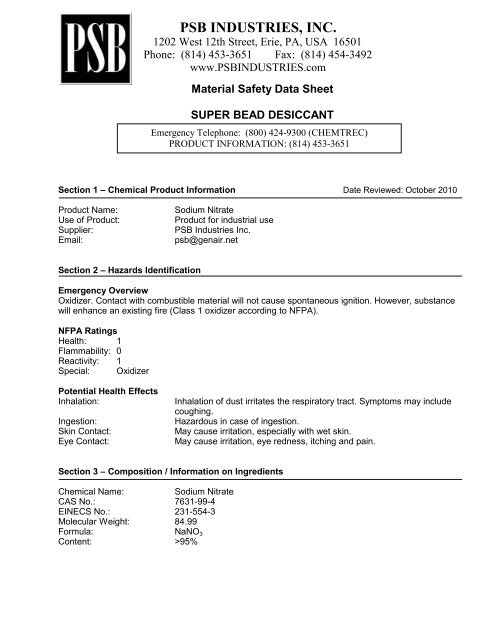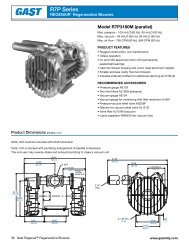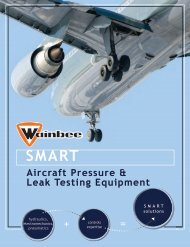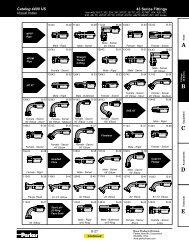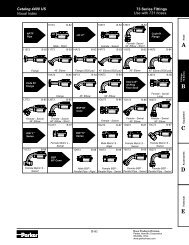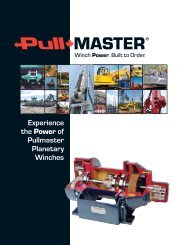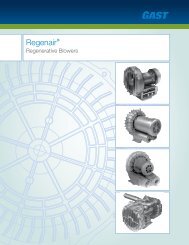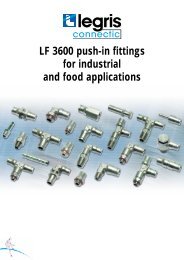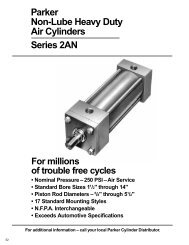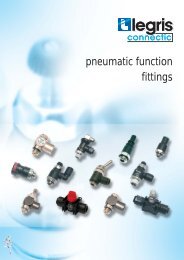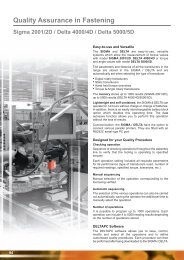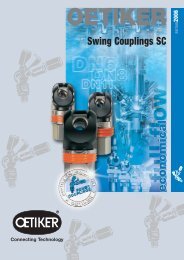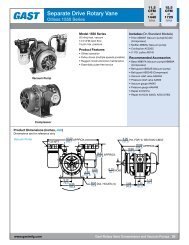PSB Super Bead - Wainbee Limited
PSB Super Bead - Wainbee Limited
PSB Super Bead - Wainbee Limited
Create successful ePaper yourself
Turn your PDF publications into a flip-book with our unique Google optimized e-Paper software.
<strong>PSB</strong> INDUSTRIES, INC.<br />
1202 West 12th Street, Erie, PA, USA 16501<br />
Phone: (814) 453-3651 Fax: (814) 454-3492<br />
www.<strong>PSB</strong>INDUSTRIES.com<br />
Material Safety Data Sheet<br />
SUPER BEAD DESICCANT<br />
Emergency Telephone: (800) 424-9300 (CHEMTREC)<br />
PRODUCT INFORMATION: (814) 453-3651<br />
Section 1 – Chemical Product Information Date Reviewed: October 2010<br />
Product Name:<br />
Use of Product:<br />
Supplier:<br />
Email:<br />
Sodium Nitrate<br />
Product for industrial use<br />
<strong>PSB</strong> Industries Inc.<br />
psb@genair.net<br />
Section 2 – Hazards Identification<br />
Emergency Overview<br />
Oxidizer. Contact with combustible material will not cause spontaneous ignition. However, substance<br />
will enhance an existing fire (Class 1 oxidizer according to NFPA).<br />
NFPA Ratings<br />
Health: 1<br />
Flammability: 0<br />
Reactivity: 1<br />
Special: Oxidizer<br />
Potential Health Effects<br />
Inhalation:<br />
Ingestion:<br />
Skin Contact:<br />
Eye Contact:<br />
Inhalation of dust irritates the respiratory tract. Symptoms may include<br />
coughing.<br />
Hazardous in case of ingestion.<br />
May cause irritation, especially with wet skin.<br />
May cause irritation, eye redness, itching and pain.<br />
Section 3 – Composition / Information on Ingredients<br />
Chemical Name:<br />
Sodium Nitrate<br />
CAS No.: 7631-99-4<br />
EINECS No.: 231-554-3<br />
Molecular Weight: 84.99<br />
Formula: NaNO 3<br />
Content: >95%
<strong>PSB</strong> Industries, Inc.<br />
Material Safety Data Sheet<br />
Page 2<br />
Section 4 – First Aid Measures<br />
General Information<br />
In case of persisting adverse effects consult a physician.<br />
Specific Measures<br />
Inhalation<br />
Ingestion<br />
Skin Contact<br />
Eye Contact<br />
Remove to fresh air. Get medical attention for any breathing difficulty.<br />
Induce vomiting. Never give anything by mouth (oral) to an unconscious<br />
person.<br />
In case of irritation, remove clothing. Wipe excess from skin. Wash with<br />
soap and water for at least 5 minutes.<br />
Flush eyes with plenty of water, lifting lower and upper eyelids<br />
occasionally.<br />
Section 5 – Firefighting Measures<br />
Fire<br />
Non combustible, but contact with combustible substances under a fire<br />
will increase combustion rate. For thermal decomposition products, refer<br />
to Section 10.<br />
Extinguishing Media<br />
- Suitable Any mean suitable for extinguishing surrounding fire. Spray water for<br />
small fires. For large fires flood with abundant water.<br />
- Not Suitable -<br />
Protective Equipment: Refer to Section 8.<br />
Section 6 – Accidental Release Measures<br />
Personal Precautions: Ventilate the area. Use personal protective equipment (Section 8).<br />
Environmental Precautions: Do not discharge into drains. Avoid surface and ground water<br />
contamination.<br />
Methods for Cleaning Up/:<br />
Taking Up<br />
Pick up the product mechanically and store in suitable containers for<br />
recovery or disposal.<br />
Section 7 – Handling and Storage<br />
Handling<br />
Special Procedures None<br />
Safe Handling Procedures Minimize dust generation. Avoid contact with eyes and skin.<br />
Special Advices Section 10.
<strong>PSB</strong> Industries, Inc.<br />
Material Safety Data Sheet<br />
Page 3<br />
Storage<br />
Special Requirements<br />
Storage Conditions<br />
Reseal carefully any opened container and set upright to avoid leakages.<br />
Keep the product in the original containers.<br />
Keep away from flammable substances. Do not store with combustibles<br />
reducing agents. Keep containers tightly closed in well ventilated and cool<br />
place.<br />
Section 8 – Exposure Controls / Personal Protection<br />
Exposure Limits<br />
Suggested according to US regulations: 15 mg/m 3 (total dust); 5 mg/ m 3 (respirable fraction)<br />
Exposure Controls<br />
Local exhaust ventilation to keep low dust environment.<br />
Personal Protective Equipment<br />
Respiratory<br />
Dust mask if necessary, i.e. in case of dust emission or dusty<br />
environments<br />
Eyes<br />
Hands<br />
Safety goggles required all the time.<br />
Nitrile rubber gloves, over 0.11 mm thickness, >480 min breakthrough<br />
time.<br />
Hygiene Measures<br />
Do not drink, eat or smoke during product manipulation. Keep away from foodstuffs and beverages.<br />
Wash hands before breaks and after work.<br />
Personal Protective<br />
Equipment<br />
Hygiene Measures<br />
Wear dust mask if necessary, nitrile rubber gloves and chemical safety<br />
goggles.<br />
Do not drink, eat or smoke during product manipulation. Keep away from<br />
foodstuffs and beverages. Wash hands before breaks and after work.<br />
Section 9 – Physical and Chemical Properties<br />
Physical Form:<br />
Solid, prilled or crystalline<br />
Color:<br />
White<br />
Odor:<br />
Odorless<br />
pH:<br />
6-9 (5% aqueous solution)<br />
Melting Point: 308°C<br />
Boiling Point:<br />
Not applicable
<strong>PSB</strong> Industries, Inc.<br />
Material Safety Data Sheet<br />
Page 4<br />
Flash Point:<br />
not applicable<br />
Flammability:<br />
not flammable<br />
Explosive Properties: not applicable<br />
Thermal Decomposition: >550°C<br />
Specific Gravity:<br />
2.26 g/mL<br />
Water Solubility:<br />
480 g/L (20°C)<br />
Partition Coefficient (log P ow ) not applicable<br />
Section 10 – Stability and Reactivity<br />
Stability<br />
Conditions to avoid<br />
Hazardous<br />
Decomposition Products<br />
Stable under normal storage and temperature conditions.<br />
Keep away from flammable, combustible and reducing substances.<br />
Nitrous oxides, sodium nitrite and sodium oxide by thermal<br />
decomposition.<br />
Section 11 – Toxicological Information<br />
Acute Data<br />
Oral LD 50 (rat): >2000mg/Kg<br />
Dermal LD 50 (rat): no data available<br />
Inhalation LD 50 : no data available<br />
Short-term Effects<br />
Inhalation may cause irritation of the respiratory tract. Can cause skin and eye irritation.<br />
Chronic Effects<br />
No adverse effects observed on developmental toxicity. Equivocal carcinogenic agent according to<br />
animal tests. Mutagenic and reproductive hazard at very high level doses according to animal tests.<br />
Section 12 – Ecological Information<br />
General<br />
Do not discharge into drains and water or public depositories.<br />
Environmental Fate<br />
Sodium Nitrate dissociates into sodium and nitrate ions. Nitrates may be absorbed by plants and<br />
converted into organic nitrogen, whereas sodium binds to clay particles in the soil.
<strong>PSB</strong> Industries, Inc.<br />
Material Safety Data Sheet<br />
Page 5<br />
Zooplankton Toxicity Fish Toxicity<br />
Species: Daphnia magna Species: Rainbow trout<br />
LC 50 3581 mg/L (48 h) LC 50 1658 mg/L (96 h)<br />
Not acutely toxic to aquatic organisms.<br />
Mobility<br />
Predicted Distribution: Water, 45%; Soil, 54.7%<br />
Section 13 – Disposal Considerations<br />
Residues:<br />
Empty Packaging:<br />
Licensed professional waste disposal service is required. Disposal of<br />
waste according to all federal, state and local regulations.<br />
Empty containers may be reused after appropriate cleansing. Packaging<br />
that can not be cleaned should be disposed in agreement with the<br />
regional waste disposal company.<br />
Section 14 – Transport Information<br />
Rail & Road (DOT) – Sea (IMDG Code) – Air (IATA)<br />
Proper Shipping Name Sodium Nitrate<br />
UN Number 1498<br />
Class 5.1<br />
Packaging Group<br />
III<br />
Hazard Label<br />
Oxidizing<br />
Section 15 – Regulatory Information<br />
US Classification<br />
Indication of Danger<br />
Risk statements<br />
Safety Statements<br />
SARA<br />
TSCA<br />
Prop. 65 (California)<br />
Oxidizing<br />
Contact with combustible material under a fire will enhance combustion.<br />
Keep away from combustible material.<br />
Avoid contact with skin and eyes.<br />
Not listed<br />
Listed<br />
Not listed
<strong>PSB</strong> Industries, Inc.<br />
Material Safety Data Sheet<br />
Page 6<br />
Section 16 – Other Information<br />
This MSDS complies with 29 CFR part 1910 subpart Z and ANSI Standard Z400.1-2004.<br />
The information above is believed to be accurate and represents the best information currently<br />
available to us. However, we make no warranty of merchantability or any other warranty, express or<br />
implied, with respect to such information, and we assume no liability resulting from its use. Users<br />
should make their own investigations to determine the suitability of the information for their particular<br />
purposes. In no event shall <strong>PSB</strong> Industries, Inc. be liable for any claims, losses, or damages of any<br />
third party or for lost profits or any special, indirect, incidental, consequential or exemplary damages,<br />
howsoever arising, even if <strong>PSB</strong> Industries, Inc. has been advised of the possibility of such damages.


